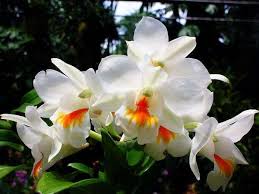# Comprehensive Guide to Propagating White Egg Orchids through Stem Cuttings

## Table of Contents
1. **Introduction**
2. **Understanding White Egg Orchids**
– 2.1. Botanical Overview
– 2.2. Characteristics of White Egg Orchids
3. **Propagation Methods Overview**
– 3.1. Why Choose Stem Cuttings?
– 3.2. Other Propagation Techniques
4. **Preparing for Propagation**
– 4.1. Tools and Materials Needed
– 4.2. Selecting the Right Parent Plant
5. **Step-by-Step Guide to Propagating White Egg Orchids by Stem Cuttings**
– 5.1. Timing Your Propagation
– 5.2. Taking Cuttings
– 5.3. Preparing the Cuttings
– 5.4. Rooting Hormones
– 5.5. Planting the Cuttings
6. **Caring for Your Cuttings**
– 6.1. Light Requirements
– 6.2. Watering and Humidity
– 6.3. Temperature and Environment
7. **Troubleshooting Common Issues**
– 7.1. Pests and Diseases
– 7.2. Signs of Stress
– 7.3. When to Reassess Your Approach
8. **Transplanting Your New Orchids**
– 8.1. Signs of Root Development
– 8.2. Choosing the Right Potting Medium
– 8.3. Repotting Techniques
9. **Long-term Care for Your New White Egg Orchids**
– 9.1. Fertilization
– 9.2. Pruning and Maintenance
– 9.3. Monitoring Growth
10. **Conclusion**
11. **FAQs**
—
## 1. Introduction
Orchids, particularly White Egg Orchids (*Phalaenopsis*), are renowned for their beauty and elegance. Propagating these stunning flowers can be a rewarding endeavor, especially when using the stem cutting method. This guide will provide detailed instructions on how to successfully propagate White Egg Orchids through stem cuttings, ensuring that you have the knowledge and tools necessary for a successful propagation process.
## 2. Understanding White Egg Orchids
### 2.1. Botanical Overview
White Egg Orchids belong to the vast family of *Orchidaceae*, known for their diverse and intricate floral structures. They are particularly popular among plant enthusiasts for their ease of care and ability to bloom repeatedly.
– **Genus:** *Phalaenopsis*
– **Common Names:** Moth Orchids, White Egg Orchids
– **Native Range:** Southeast Asia, specifically in tropical and subtropical regions.
### 2.2. Characteristics of White Egg Orchids
These orchids are characterized by their broad, flat petals that can vary in color, though the White Egg variety is specifically known for its white blooms. The flowers often have a subtle fragrance and can last for several weeks to months, making them a favorite for indoor decor.
## 3. Propagation Methods Overview
### 3.1. Why Choose Stem Cuttings?
Stem cuttings are one of the most efficient and straightforward methods for propagating orchids. This method allows for the production of new plants from existing ones without requiring complex techniques such as division or tissue culture. Stem cuttings can be a great way to expand your collection of White Egg Orchids with relatively low investment and effort.
### 3.2. Other Propagation Techniques
While stem cuttings are effective, other methods include:
– **Division:** Splitting mature plants into smaller sections, each with roots.
– **Keikis:** Baby orchids that grow on the flower stalk of the parent plant, which can be removed and planted separately.
– **Tissue Culture:** A laboratory method involving growing new plants from cells or tissues.
## 4. Preparing for Propagation
### 4.1. Tools and Materials Needed
Before starting your propagation process, gather the necessary tools and materials:
– Sharp, sterilized scissors or a razor blade
– Rooting hormone (optional)
– Clean pots or containers with drainage holes
– Well-draining potting medium (orchid bark mix or sphagnum moss)
– Plastic wrap or a humidity dome (to maintain humidity)
### 4.2. Selecting the Right Parent Plant
Choose a healthy and robust White Egg Orchid for propagation. Look for a plant that has:
– Healthy leaves with no signs of yellowing or damage
– A strong root system
– At least one mature flower spike or stem for cutting
## 5. Step-by-Step Guide to Propagating White Egg Orchids by Stem Cuttings
### 5.1. Timing Your Propagation
The best time to take stem cuttings is during the active growing season, which typically occurs in spring or early summer. This timing encourages faster rooting and growth.
### 5.2. Taking Cuttings
1. **Select a Flower Spike:** Choose a healthy flower spike that has finished blooming. Look for a stem that is at least 6-8 inches long and has several nodes (the small bumps on the stem).
2. **Make the Cut:** Using sterilized scissors or a razor blade, make a clean cut just below a node. This node is essential for rooting, as it contains the tissue that will develop into new roots.
### 5.3. Preparing the Cuttings
1. **Remove Lower Leaves:** Carefully remove any leaves from the lower part of the cutting, leaving at least two leaves at the top to provide energy for the new plant.
2. **Allow to Callus:** Let the cuttings dry in a shaded area for a few hours to allow the cut end to callus over. This step helps prevent rot when planted.
### 5.4. Rooting Hormones
Applying rooting hormone to the cut end of the stem can significantly enhance root development. Dip the callused end of the cutting into the rooting hormone, tapping off any excess powder.
### 5.5. Planting the Cuttings
1. **Prepare the Potting Medium:** Fill a clean pot with your chosen potting medium. If using orchid bark, ensure it is well-draining.
2. **Insert the Cutting:** Make a small hole in the medium and gently insert the cut end of the stem, ensuring that at least one node is buried. Firmly pack the medium around the base to provide stability.
3. **Watering:** Lightly water the medium to settle it around the cutting, but do not saturate it. Excess moisture can lead to rot.
## 6. Caring for Your Cuttings
### 6.1. Light Requirements
Place the pot in a location with bright, indirect sunlight. Avoid direct sunlight, as it can scorch the cutting. A south or east-facing window is often ideal.
### 6.2. Watering and Humidity
Maintain high humidity around the cuttings to encourage rooting. You can achieve this by covering the pot with plastic wrap or using a humidity dome. Make sure to:
– **Mist regularly** to maintain humidity levels.
– **Water sparingly**, allowing the medium to dry slightly between waterings.
### 6.3. Temperature and Environment
White Egg Orchids thrive in warm temperatures, ideally between 70°F to 80°F (21°C to 27°C) during the day and slightly cooler at night. Ensure good air circulation to prevent mold and fungal issues.
## 7. Troubleshooting Common Issues
### 7.1. Pests and Diseases
Keep an eye out for common pests such as aphids, mealybugs, and spider mites. If detected, treat them with insecticidal soap or neem oil. Fungal issues can occur if humidity is too high, so ensure proper airflow.
### 7.2. Signs of Stress
Monitor your cuttings for signs of stress, including:
– **Yellowing leaves:** This may indicate overwatering or poor light conditions.
– **Wilting:** This could be a sign of underwatering or high temperatures.
### 7.3. When to Reassess Your Approach
If your cuttings are not showing signs of rooting after several weeks (typically 4-8 weeks), it may be necessary to reassess your approach. Check for signs of rot and consider trying new cuttings if necessary.
## 8. Transplanting Your New Orchids
### 8.1. Signs of Root Development
After several weeks, check for root development by gently tugging on the cutting. If you feel resistance, roots are likely forming. Additionally, you may see new growth emerging from the top of the cutting.
### 8.2. Choosing the Right Potting Medium
When your cuttings have developed strong roots, it’s time to transplant them into larger pots. Choose a well-draining orchid mix, which typically consists of bark, sphagnum moss, and perlite.
### 8.3. Repotting Techniques
1. **Gently Remove the Cutting:** Carefully take the rooted cutting out of its current pot, being cautious not to damage the roots.
2. **Position the Cutting:** Place the cutting in the new pot, ensuring that the roots are spread out and not cramped. Fill in with fresh potting medium, ensuring the base of the plant is level with the top of the pot.
3. **Water Thoroughly:** Water the newly potted orchid to help settle the medium around the roots.
## 9. Long-term Care for Your New White Egg Orchids
### 9.1. Fertilization
Once your new orchids are established, regular fertilization will promote healthy growth and flowering. Use a balanced orchid fertilizer, diluted to half strength, every two to four weeks during the growing season.
### 9.
2. Pruning and Maintenance
Regularly check for dead or yellowing leaves and prune them away to promote healthy growth. Additionally, monitor for any signs of pests or diseases.
### 9.3. Monitoring Growth
Keep an eye on your orchids’ growth patterns. Healthy White Egg Orchids should produce new leaves and flowers regularly, indicating successful care and maintenance.
## 10. Conclusion
Propagating White Egg Orchids through stem cuttings is a fulfilling and accessible way to expand your orchid collection. By following the steps outlined in this guide, you can successfully grow new plants from your existing ones and enjoy the beauty of these elegant flowers for years to come.
Happy gardening!
## 11. FAQs
### Q1: How long does it take for White Egg Orchid cuttings to root?
**A1:** It usually takes 4 to 8 weeks for cuttings to develop roots, depending on environmental conditions.
### Q2: Can I propagate White Egg Orchids in water?
**A2:** While it’s possible to root orchids in water, it’s generally less effective than using a well-draining medium.
### Q3: What should I do if my cutting doesn’t root?
**A3:** If a cutting fails to root, check for signs of rot or pest infestations. You may need to try again with a new cutting.
### Q4: Do White Egg Orchids require special care compared to other orchids?
**A4:** While they have similar care needs, White Egg Orchids may require specific attention to humidity and light conditions for optimal growth.
### Q5: How often should I water my new orchids after transplanting?
**A5:** Water your new orchids when the top inch of the potting medium feels dry, typically every 1-2 weeks, depending on humidity and temperature.
—
This detailed guide on propagating White Egg Orchids through stem cuttings offers a comprehensive approach to expanding your orchid collection. With patience and care, you’ll be rewarded with beautiful blooms and thriving plants.

